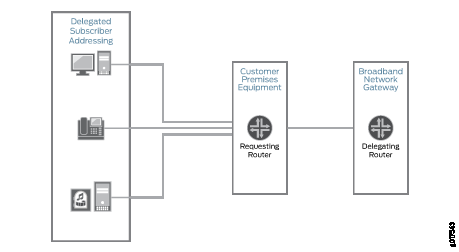Overview of Using DHCPv6 Prefix Delegation
You can use DHCPv6 prefix delegation to automate the delegation of IPv6 prefixes to the CPE. With prefix delegation, a delegating router (the BNG) delegates IPv6 prefixes to a requesting router (the CPE). The requesting router then uses the prefixes to assign global IP addresses to the devices on the subscriber LAN. The requesting router can also assign subnet addresses to subnets on the LAN.
DHCPv6 prefix delegation is useful when the delegating router does not have information about the topology of the networks in which the requesting router is located. In such cases, the delegating router requires only the identity of the requesting router to choose a prefix for delegation.
DHCPv6 prefix delegation replaces the need for NAT in an IPv6 network.
Figure 1 shows how DHCPv6 prefix delegation is used in a dual-stack network.

DHCPv6 prefix delegation operates as follows:
A delegating router is provided with IPv6 prefixes to be delegated to requesting routers.
These prefixes can come from a local address-assignment pool or an external AAA server. Each prefix has an associated valid and preferred lifetime, which can be extended.
A requesting router requests one or more prefixes from the delegating router.
The delegating router chooses prefixes for delegation, and responds with prefixes to the requesting router.
The requesting router is then responsible for the delegated prefixes.
The address allocation mechanism in the subscriber network can be performed with ICMPv6 Neighbor Discovery in router advertisements, DHCPv6, or a combination of these two methods.





















